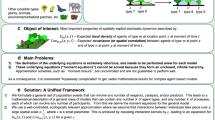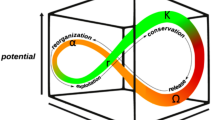Abstract
The issue of whether formal reasoning or a computing-intensive approach is the most efficient manner to address scientific questions is the subject of some considerable debate and pertains not only to the nature of the phenomena and processes investigated by scientists, but also the nature of the equation and algorithm objects they use. Although algorithms and equations both rely on a common background of mathematical language and logic, they nevertheless possess some critical differences. They do not refer to the same level of symbolization, as equations are based on integrated concepts in a denotational manner, while algorithms specifically break down a complex problem into more elementary operations, in an operational manner. They may therefore be considered as suited to the representation of different phenomena. Specifically, algorithms are by nature sufficient to represent weak emergent phenomena, but not strong emergent patterns, while equations can do both. Finally, the choice between equations and algorithms are by nature sufficient to represent weak emergent phenomena, but not strong emergent patterns, while equations behave conversely. We propose a simplified classification of scientific issues for which both equation- and/or algorithm-based approaches can be envisaged, and discuss their respective pros and cons. We further discuss the complementary and sometimes conflicting uses of equations and algorithms in a context of ecological theory of metapopulation dynamics. We finally propose both conceptual and practical guidelines for choosing between the alternative approaches.


Similar content being viewed by others
References
Aubin D (1997) The withering immortality of Nicolas Bourbaki: a cultural connector at the confluence of mathematics. Sci Context 10:297–342
Bascompte J (2001) Aggregate statistical measures and metapopulation dynamics. J Theor Biol 209:373–379
Bascompte J (2003) Extinction threshold: insights from simple models. Ann Zool Fennici 40:99–114
Bascompte J, Sole RV (1996) Habitat fragmentation and extinction thresholds in spatially explicit models. J Anim Ecol 65(4):465–473
Bedau MA (2008) Is weak emergence just in the mind? Mind Mach 18(4):443–459
Berec L (2002) Techniques of spatially explicit individual-based models: construction, simulation, and mean-field analysis. Ecol Model 150(1–2):55–81
Bolker B, Pacala SW (1997) Using moment equations to understand stochastically driven spatial pattern formation in ecological systems. Theor Popul Biol 52:179–197
Boogerd FC, Bruggeman FJ, Richardson RC, Stephan A, Westerhoff HV (2005) Emergence and its place in nature: a case study of biochemical networks. Synthese 145:131–164
Broad CD (1919) Mechanical explanation and its alternatives. Proc Aristotelian Soc 19:86–124
Broad CD (1925) In: Kegan Paul T (ed) The mind and its place in nature. Trubner & Co, London
Buchberger B (1976) Theoretical basis for the reduction of polynomials to canonical forms. ACM SIGSAM Bull 10(3):19–29
Burris SN, Sankappanavar HP (1981) A course in universal algebra. Springer Verlag, Berlin
Church A (1941) The calculi of lambda-conversion. Princeton University Press, Princeton
Cormen TH, Leiserson CE, Rivest RL, Stein C (2001) (eds) Introduction to algorithms, 2nd edn. The Massasuchetts Institute of Technology, USA
Dewdney AK (1985) Analog gadgets that solve a diversity of problems and raise an array of questions. Sci Am 252(5):18–24
Epstein J (1999) Agent-based computational models and generative social science. Complexity 4(5):41–60
Faugeras B, Maury O (2007) Modeling fish population movements: from an individual-based representation to an advection-diffusion equation. J Theor Biol 247(4):837–848
Gödel K (1931) Über formal unentscheidbare Sätze der principia mathematica und verwandter systeme. I. Monatshefte für Mathematik und Physik 38:173–198
Gosselin F (1999) Test of mathematical assumptions behind the ‘incidence function’ estimation process of metapopulations’ dynamic parameters. Math Biosci 159(1):21–32
Hales TC (2001) The honeycomb conjecture. Discrete Comput Geom 25(1):1–22
Hanski I (1997) Predictive and practical metapopulation models: the incidence function approach. In: Tilman D, Kareiva P (eds) Spatial ecology—the role of space in population dynamics and interspecific interactions. Princeton University Press, Princeton, pp 21–45
Hanski I (1998) Metapopulation dynamics. Nature 396:41–49
Hanski IA, Gilpin ME (eds) (1997) Metapopulation biology, vol 1. Academic Press, San Diego
Hoare CAR (1999) A theory of programming: denotational, algebraic and operational semantics, in, http://www.research.microsoft.com/users/thoare/A_theory_of_programming.pdf
Humphreys P (2004) Extending ourselves: computational science, empiricism, and scientific method. Oxford University Press, Oxford
Humphreys P (2008) Synchronic and diachronic emergence. Mind Mach 18(4):431–442
Huneman P (2008) Emergence made ontological? computational versus combinatorial approaches. Philos Sci 75(5):595–607
Huneman P, Humphreys P (2008) Dynamical emergence and computation: an introduction. Mind Mach 18(4):425–430
Keeling MJ (2002) Using individual-based simulations to test the Levins metapopulation paradigm. J Anim Ecol 71(2):270–279
Lande R (1987) Extinction thresholds in demographic models of territorial populations. Am Nat 130:624–635
Latour B (1987) Science in action, how to follow scientists and engineers through society. Harvard University Press, Cambridge Mass
Law R, Murrell DJ, Dieckmann U (2003) Population growth in space and time: spatial logistic equations. Ecology 84(1):252–262
Levi M (2009) The mathematical mechanic: using physical reasoning to solve problems. Princeton University Press, Princeton
Levins R (1966) Strategy of model building in population biology. Am Sci 54(4):421
Levins R (1969) Some demographic and genetic consequences of environmental heterogeneity for biological control. Bull Entomol Soc Am 15:237–240
Morin E (1982) Science avec conscience. Vol. (new edition). Collection Points, Fayard
Munoz F, Cheptou P-O, Kjellberg F (2007) Spectral analysis of simulated species distribution maps provides insights into metapopulation dynamics. Ecol Model 105:314–322
Ovaskainen O, Sato K, Bascompte J, Hanski I (2002) Metapopulation models for extinction threshold in spatially correlated landscapes. J Theor Biol 215:95–108
Peck SL (2004) Simulation as experiment: a philosophical reassessment for biological modeling. Trends Ecol Evol 19(10):530–534
Plotkin GD (2004) A structural approach to operational semantics. J Log Algebraic Program 60–61:17–139
Saccheri I, Kuussaari M, Kankare M, Vikman P, Fortelius W, Hanski I (1998) Inbreeding and extinction in a butterfly metapopulation. Nature 392
Schmidt DA (1986) Denotational semantics. A methodology for language development. Allyn and Bacon, Inc., Boston
Shapiro S (1997) Philosophy of mathematics: structure and ontology. Oxford University Press, Oxford
Solé RV, Manrubia SC, Benton M, Kauffman S, Bak P (1999) Criticality and scaling in evolutionary ecology. Trends Ecol Evol 14(4):156–160
Stephan A (1999) Varieties of emergentism. Evol Cogn 5(1):49–59
Szpiro G (2003) Mathematics: does the proof stack up? Nature 424(6944):12–13
Turing AM (1936) On computable numbers, with an application to the entscheidungsproblem. Proc Lond Math Soc 2(42):230–265
Turner R, Eden AH (2007) The philosophy of computer science: introduction to the special issue. Mind Mach 17(2):129–133
Vuorinen V, Peltomaki M, Rost M, Alava MJ (2004) Networks in metapopulation dynamics. Euro Phys J B 38(2):261–268
Wigner E (1982) On science and its evolution. J Phys 43(NC-8):435–438
With KA, King AW (1999) Extinction thresholds for species in fractal landscapes. Conserv Biol 13(2):314–326
Wolfram S (2002) A new kind of science. Wolfram media, Champaign
Acknowledgments
We are grateful to the organizers of the European Conference on Computing And Philosophy (ECAP 2008). We warmly thank P. Huneman for advices on an earlier version of this paper.
Author information
Authors and Affiliations
Corresponding author
Rights and permissions
About this article
Cite this article
Gaucherel, C., Bérard, S. & Munoz, F. Equation or Algorithm: Differences and Choosing Between Them. Acta Biotheor 59, 67–79 (2011). https://doi.org/10.1007/s10441-010-9119-4
Received:
Accepted:
Published:
Issue Date:
DOI: https://doi.org/10.1007/s10441-010-9119-4




